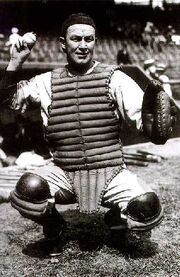
Charles Leo "Gabby" Hartnett (December 20, 1900 - December 20, 1972) was an National Major League Baseball catcher and manager who played nearly his entire career with the Chicago Cubs. He is widely considered to have been the greatest National League catcher in the first half of the 20th century.
Hartnett was born in Woonsocket, Rhode Island as the oldest of 14 children. Joining the Cubs in 1922, he proved himself an excellent backstop through the 1920s; but a succession of injuries often kept him out of the lineup. He kept pace with the increasing offense of the "live ball" era, hitting 24 home runs in 1925 to finish second in the league. 1929 was especially frustrating, as an inexplicable sore arm limited him to one game behind the plate and 24 games as a pinch-hitter as the Cubs won the pennant; Hartnett would strike out in all three of his World Series at bats. But he rebounded with a remarkable season in 1930, hitting .339 with career highs of 37 home runs - then a record for catchers - and 122 runs batted in. In the meantime, his quiet and unpretentious manner had inspired teammates to give him his famous nickname out of irony.
On October 1, 1932, Gabby was behind the plate during Babe Ruth's infamous Called Shot.
Moving into his 30s, when most catchers find themselves wearing out, Hartnett was just getting started. Although he had caught over 100 games only four times in the 1920s, he would do so for the next eight consecutive seasons (1930-37), and in 1939 he broke Ray Schalk's Major League record of 1,727 career games as a catcher. Hartnett also finished among the NL's top ten in slugging percentage seven times in his career.
Named an NL All-Star for the first six games that were played (1933-38), Hartnett was catching when pitcher Carl Hubbell set a record in the 1934 game by striking out Babe Ruth, Lou Gehrig, Jimmie Foxx, Al Simmons, and Joe Cronin in succession.
Hartnett was named the NL's MVP in 1935, after batting .344 (third in the league) and topping league catchers in assists, double plays, and fielding average to lead the Cubs to the pennant. In 1937 he was the league's MVP runnerup after batting .354, again third in the NL. He was named the Cubs' manager in the middle of the 1938 season, replacing Charlie Grimm.
On September 28, 1938, with the Cubs trailing Pittsburgh by only half a game, he experienced the highlight of his career. The lightless Wrigley Field was gradually being overcome by darkness in a hard-fought game with the Pirates, the score tied 5-5; if it had become too dark, the game would have needed to be replayed from the beginning. With two out in the bottom of the ninth, two strikes on him, and the umpires ready to end the game, Hartnett launched a shot into the gloom and haze which would be remembered as his "Homer in the Gloamin'". The Cubs were now in first place, culminating a tremendous 19-3-1 September run, and the pennant would be clinched three days later. Unfortunately, the Cubs were swept in the World Series by the New York Yankees, their fourth Series loss in ten years.
He continued to manage the Cubs through the 1940 season. In 1941 he left to play for, and coach, the New York Giants, hitting .300 in his final year as a player. He ended his 20-year career with a .297 batting average and a .489 slugging percentage; his 236 home runs, 1179 runs batted in, 1912 hits, and 396 doubles were all records for catchers. His bat and catcher's mask were the first artifacts sent to the newly constructed Baseball Hall of Fame in 1938.
Afterward he managed in the minor leagues for five seasons, retiring to Lincolnwood, Illinois in 1946. Gabby Hartnett was inducted into the Baseball Hall of Fame in 1955. In 1981, Lawrence Ritter and Donald Honig included him in their book The 100 Greatest Baseball Players of All Time. In 1999, he was named as a finalist to the Major League Baseball All-Century Team.
Later he worked as a coach and scout for the Kansas City Athletics for two years in the mid-1960s. He died of cirrhosis in Park Ridge, Illinois on his 72nd birthday.
Gabby Hartnett is interred in All Saints Cemetery in Des Plaines, Illinois.
See also[]
External links[]
- Career statistics and player information from Baseball-Reference, or Fangraphs, or The Baseball Cube
- baseballhalloffame.org – Hall of Fame biography page
| Preceded by: Dizzy Dean |
National League Most Valuable Player 1935 |
Succeeded by: Carl Hubbell |
| Preceded by: Charlie Grimm |
Chicago Cubs Manager 1938–1940 |
Succeeded by: Jimmie Wilson |
